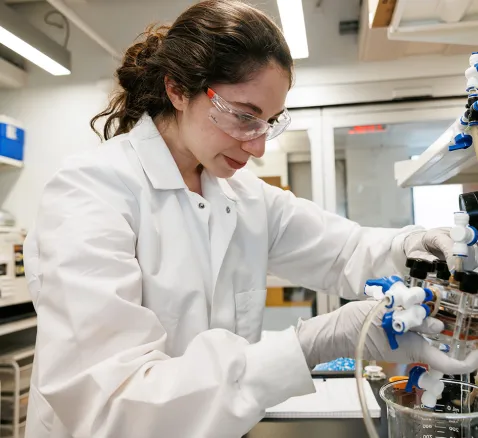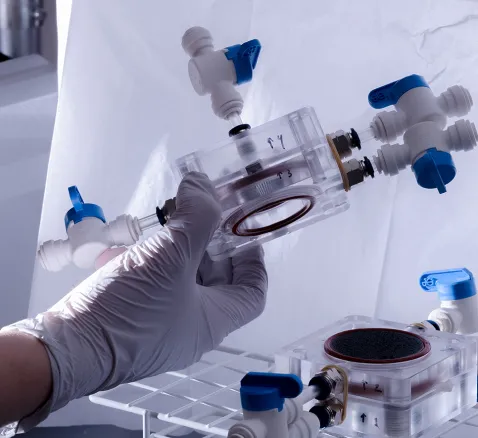With a molecule and a membrane, a better way to convert contamination into fuel
Electrochemically converting the nitrate found in contaminated water into ammonia offers a potentially environmentally friendly solution for both water treatment and developing fossil-free fertilizer and carbon-free fuels. Finding an efficient, inexpensive way to do so, though, hasn’t been easy. Yale researchers, though, may have found the solution. The results are published in Nature Chemical Engineering.
The problem:
Nitrate, a pollutant found in wastewater, can be converted into ammonia that can then be turned into fertilizer, carbon-free fuel, and other useful products. The main challenges of doing so, though, involve what researchers in the field call selectivity and activity. That is, you want to convert the nitrate to ammonia while creating the least amount of byproducts, and you want to do it quickly, explained Lea Winter, who led the study and is a professor of chemical & environmental engineering.
One way that researchers address these challenges is by focusing on innovations to the electrocatalysts that trigger the conversion reactions. “By manipulating the material properties, you can make the catalyst more active and more selective,” Winter said. But that can be expensive.
“When you're using expensive materials and complicated synthesis techniques to make these fine-tuned nanostructured materials, then you add a lot of cost,” Winter said. “And if we're ending up with something that's high cost because of these expensive metals, then it becomes prohibitive. That's especially true when you’re trying to mitigate nitrate in wastewater through this method.”
The solution:
Winter’s research group took a two-pronged approach. For one, they added to their system an ionophore, a molecule attracted to certain ions - in this, case, nitrite. That’s useful because when you’re converting nitrate to ammonia, nitrite is a by-product that gets formed along the way. Sometimes, it escapes back into the water before it has been fully converted to ammonia.
“So our trick here was to incorporate the ionophore, which is good at keeping nitrite nearby, allowing it to get converted to ammonia before it gets released back into the water. And that's our key to getting the very high ammonia selectivity.”
For the second part of their technology, they incorporated an electrified membrane made from copper and carbon nanotubes, an electrochemical conversion platform that Winter’s lab specializes in. It’s what allows the system to convert the ammonia to nitrate so quickly. “Part of the challenge is that, because the membrane works so quickly, you actually end up getting a lot of nitrite,” Winter said. “But when we combine the electrified membrane with the ionophore, we get both the very high activity as well as the high ammonia selectivity without having to compromise one or the other.”
The results:
Compared to other systems that focus on selectivity and activity, Winter’s comes out ahead by far. While other systems operate on a scale of hours, Winter’s method gets nitrate through the membrane and converted to ammonia in only six seconds. Further, an impressive 92 percent of the nitrate is turned into ammonia.
Going forward:
To test their system in a real-world application, the researchers used it on water from a lake near the Yale campus and from a wastewater treatment plant at the University of Connecticut. In both cases, they found that their system passed a crucial test of remaining stable for several hours. Further, because the membranes are very flexible, Winter said there are opportunities to scale it up to the level of conventional water treatment processes.
More Details
Published Date
Jun 23, 2025


